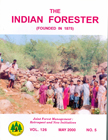Monitoring of Joint Forest Management in India : Issues and Methods
DOI:
https://doi.org/10.36808/if/2000/v126i5/3199Abstract
Most of the States of India have adopted J oint Forest Management (JFM) to halt the trend of forest degradation and reverse the trend. The performance of JFM varies from village to village and State to State. Given the stakes involved and complexity of ground realities, monitoring of JFM is critically important for the success of JFM. In the paper three methods of monitoring viz. Comprehensive Monitoring, Mid-term Monitoring and Six Monthly In-house Monitoring have been suggested. Comprehensive Monitoring, to be taken once after five years, reviews JFM with respect to health of forests, people's participation and perception, environmental factors, economic viability, performance of FPC and micro-plan. Weighted Criteria Method has been suggested for calculation of index scpre for each FPC, division and state and Delphi Technique may be used for arriving at consensus on weights of different criteria. In this methods index score for each FPC, Division and State shall be calculated. The score shall represent the performance of JFM in the area. Detailed spatial and temporal analysis shall be carried out with the help of GIS package. Mid-term Monitoring is comparatively less comprehensive and monitors the implementation of micro-plan and functioning of FPC. It may come out with the solution of existing or emerging problems. Six Monthly In-house Monitoring is simplistic and focuses on micro.plan. These methods may be modified according to local situation. Hopefully, the monitoring methods will go long way in making JFM successful and viable system.Downloads
Download data is not yet available.
Downloads
Published
2000-05-01
How to Cite
Prasad, B. (2000). Monitoring of Joint Forest Management in India : Issues and Methods. Indian Forester, 126(5), 516–524. https://doi.org/10.36808/if/2000/v126i5/3199
Issue
Section
Articles
License
Unless otherwise stated, copyright or similar rights in all materials presented on the site, including graphical images, are owned by Indian Forester.





